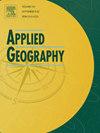Unveiling the spatially varied nonlinear effects of urban built environment on housing prices using an interpretable ensemble learning model
IF 4
2区 地球科学
Q1 GEOGRAPHY
引用次数: 0
Abstract
The relationship between urban built environment (UBE) and housing prices manifests as complex, exhibiting significant nonlinearities and spatial heterogeneity that remain inadequately understood. Taking Shanghai as a testbed, this study employs a novel ensemble learning approach, augmented by Bayesian optimization and Monte Carlo simulation, to decipher the intricate and nonlinear impacts of UBE factors on housing markets across diverse urban geographies. Our analysis unveils substantial spatial variations in how transit accessibility, amenities, residential density, and green/blue spaces influence real estate values. Proximity to metro stations and bike-sharing facilities exerts a more pronounced positive effect than bus stops. Moreover, residents in central areas demonstrate a higher willingness-to-pay for public service amenities, while those in outer suburbs prioritize access to public transportation infrastructure. Intriguingly, it invokes an optimal threshold range of urban density for properties in new cities, thereby increasing the vitality and dense socio-economic networks. Furthermore, the sprawling suburbs have identified an adverse economic impact of large conservation green/blue spaces. These insights can guide policymakers in crafting spatially-tailored strategies that harness localized built environment drivers to catalyse equitable and prosperous urban development. Tailored policies informed by this spatially explicit understanding of nonlinear built environment-housing interactions can foster more sustainable, liveable, and inclusive cities.
利用可解释的集合学习模型揭示城市建筑环境对房价的空间非线性影响
城市建筑环境(UBE)与房价之间的关系错综复杂,表现出显著的非线性和空间异质性,但人们对这一关系的认识仍然不足。本研究以上海为试验平台,采用了一种新颖的集合学习方法,并辅以贝叶斯优化和蒙特卡洛模拟,来解读城市建筑环境因素对不同城市地域住房市场的复杂非线性影响。我们的分析揭示了公交可达性、便利设施、住宅密度和绿地/蓝地对房地产价值的影响存在巨大的空间差异。与公交车站相比,靠近地铁站和共享单车设施会产生更明显的积极影响。此外,中心区的居民对公共服务设施的支付意愿更高,而外围郊区的居民则优先考虑公共交通基础设施。耐人寻味的是,它为新城市的房产设定了一个最佳的城市密度阈值范围,从而增强了新城市的活力和密集的社会经济网络。此外,无序扩张的郊区还发现了大型保护性绿地/蓝地对经济的不利影响。这些见解可以指导政策制定者制定空间定制战略,利用本地化的建筑环境驱动因素来促进公平和繁荣的城市发展。通过对建筑环境与住房之间非线性相互作用的空间明确理解,制定有针对性的政策,可以促进城市的可持续发展、宜居性和包容性。
本文章由计算机程序翻译,如有差异,请以英文原文为准。
求助全文
约1分钟内获得全文
求助全文
来源期刊

Applied Geography
GEOGRAPHY-
CiteScore
8.00
自引率
2.00%
发文量
134
期刊介绍:
Applied Geography is a journal devoted to the publication of research which utilizes geographic approaches (human, physical, nature-society and GIScience) to resolve human problems that have a spatial dimension. These problems may be related to the assessment, management and allocation of the world physical and/or human resources. The underlying rationale of the journal is that only through a clear understanding of the relevant societal, physical, and coupled natural-humans systems can we resolve such problems. Papers are invited on any theme involving the application of geographical theory and methodology in the resolution of human problems.
 求助内容:
求助内容: 应助结果提醒方式:
应助结果提醒方式:


